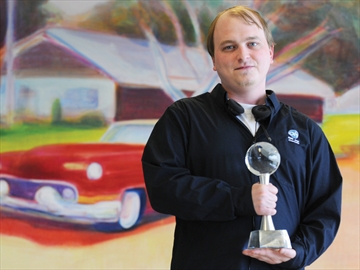By Chris Bruce, Autoblog.com - General Motors might be in the middle of a recall crisis, but safety advancements for new cars is still top of mind. In coordination with the National Highway Traffic Safety Administration Click It or Ticket campaign, the automaker is announcing a new, optional Belt Assurance System on some of its fleet models for later this year.
The system ensures that both the driver and front passenger are wearing their seat belts by not letting the vehicle shift out of Park if it detects that they aren't buckled. GM spokesperson Jennifer Ecclestone tells Autoblog that the system uses the same sensor as the airbag to detect whether someone is in the seat. The vehicle can still turn on, just not drive.
The feature will be offered as an option in 2015 model year examples of the Chevrolet Cruze, Colorado, Silverado and GMC Sierra. However, this won't be an option that normal buyers will be able to order. "We are rolling it out with a small group of fleet customers first," said Ecclestone. The fleets will be able to spec the Belt Assurance System for no additional cost beginning in the third or fourth quarter of 2014. With a positive response, Ecclestone indicated GM could offer the technology more widely.
According to NHTSA, 87 per cent of drivers already wear seat belts as of 2013, but they are still the best way to save lives in a car accident. Of course, we can totally see how this system could become a nuisance if the sensors malfunction. What do you think? Is it a good idea to not let a vehicle move unless the front passengers are belted?
The system ensures that both the driver and front passenger are wearing their seat belts by not letting the vehicle shift out of Park if it detects that they aren't buckled. GM spokesperson Jennifer Ecclestone tells Autoblog that the system uses the same sensor as the airbag to detect whether someone is in the seat. The vehicle can still turn on, just not drive.
The feature will be offered as an option in 2015 model year examples of the Chevrolet Cruze, Colorado, Silverado and GMC Sierra. However, this won't be an option that normal buyers will be able to order. "We are rolling it out with a small group of fleet customers first," said Ecclestone. The fleets will be able to spec the Belt Assurance System for no additional cost beginning in the third or fourth quarter of 2014. With a positive response, Ecclestone indicated GM could offer the technology more widely.
According to NHTSA, 87 per cent of drivers already wear seat belts as of 2013, but they are still the best way to save lives in a car accident. Of course, we can totally see how this system could become a nuisance if the sensors malfunction. What do you think? Is it a good idea to not let a vehicle move unless the front passengers are belted?
